Oracle unveils digital assets and tokenization platform for banks


In a bid to dethrone Wikipedia, Elon Musk’s xAI has launched Grokipedia, an AI-generated online encyclopedia. With over 885,000 articles, xAI Grokipedia promises to deliver faster and more factual information.
According to recent reports, xAI, the company behind Elon Musk’s Grok platform, gave birth to a rival to the online knowledge powerhouse. The tech billionaire claims that the platform will be a “massive improvement over Wikipedia,” addressing it as a “woke” Wikipedia.
Tech billionaire Elon Musk launched xAI Grokipedia, an alternative to the uncontested titan, Wikipedia. Criticizing Wikipedia for harbouring “editorial bias” and “ideological narratives,” Musk intends to position his platform to provide fast, factual, and less biased information. In a September X post, Musk wrote,
“We are building Grokipedia @xAI. Will be a massive improvement over Wikipedia. Frankly, it is a necessary step towards the xAI goal of understanding the Universe.”
Despite initial technical hiccups, xAI Grokipedia went live at grokipedia.com on Monday. The platform, powered by Grok, aims to transform the way online knowledge is created and shared. After launching in the afternoon, the site experienced a brief outage due to high traffic, but was restored by the evening.
Notably, Grokipedia, the AI-powered online encyclopedia, boasts around 885,000 articles, a significant difference from Wikipedia’s vast repository of over 7 million articles in English alone. While Wikipedia has a more extensive collection, Grokipedia’s AI-driven approach enables faster updates and potentially more objective information.
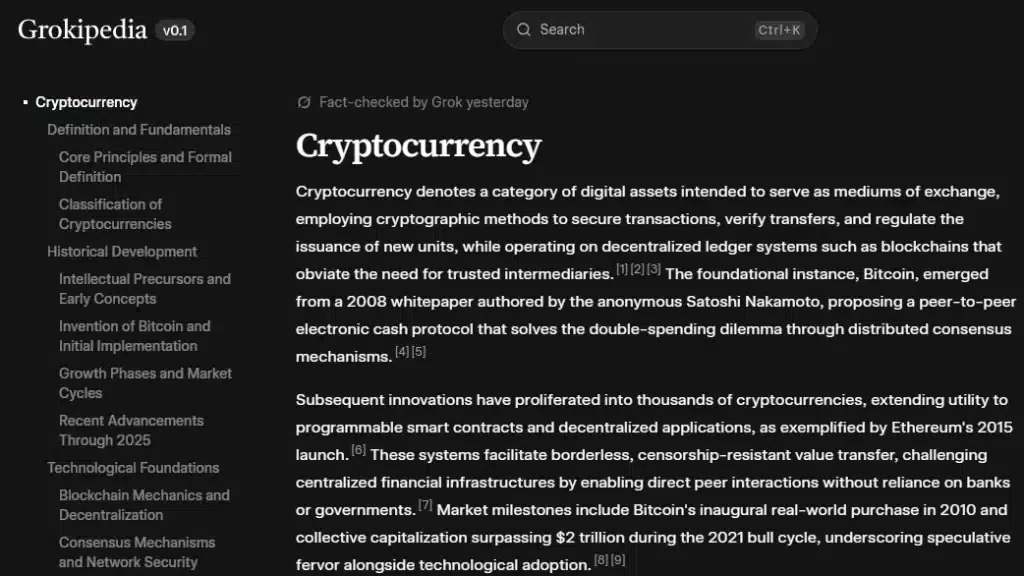
Both platforms differ significantly in their approaches to content generation, editing access, and neutrality. Grokipedia uses an AI system in xAI’s Grok model to create and edit articles, using AI technology to update articles more quickly and with less potential bias than human editing allows. On the other hand, Wikipedia is entirely dependent on human volunteers to research, create, and edit entries.
While Grokipedia provides users the ability to submit feedback, the editing function is less available, whereas Wikipedia allows article editing and contributions from anyone.
According to Musk’s Twitter post, even in its early stage, Grokipedia is superior to Wikipedia; he noted that “version 0.1” is “better than Wikipedia,” promising that “Version 1.0 will be 10X better.”
Significantly, the xAI Grokipedia launch stems from Elon Musk’s long-standing criticism of Wikipedia. He believes that the latter is dominated by “far-left activists” and has an “extremely left-biased” editorial approach.
Musk has repeatedly expressed concerns about Wikipedia’s editorial bias, transparency, and potential manipulation of information. In a December 2019 post, he noted,
“Just looked at my wiki for 1st time in years. It’s insane!…Btw, can someone please delete ‘investor’. I do basically zero investing.”
Currently, many of the articles on the new platform appear to be derived from the existing online encyclopedia. But Musk aims to transition away from relying on Wikipedia’s content by the end of the year, leveraging xAI’s Grok model to generate articles instead. In his recent statement, reiterating the vision of xAI Grokipedia, the tech leader stated,
“The goal of Grok and Grokipedia is the truth, the whole truth and nothing but the truth. We will never be perfect, but we shall nonetheless strive towards that goal.”
To summarize, Grokipedia, an xAI initiative from Elon Musk, has launched with more than 885,000 articles and intends to compete with Wikipedia. Technical issues were apparent in the early experience, but the platform is billed as more regular and frequent, with quality articles produced faster.
Despite Grokipedia’s capacity to produce overwhelming amounts of information with an AI model, there are still considerable concerns about the potential for bias and whether it is factually correct. Moving forward, it will be interesting to see whether xAI can improve Grokipedia by balancing rapid updates with building reliability and trust with users; all attempts at launching in Version 1.0 are pointed to being ’10X better.’
Read More: Will Elon Musk’s xAI Grokipedia Replace Wikipedia?">Will Elon Musk’s xAI Grokipedia Replace Wikipedia?


The post Securitize IPO to bring tokenization to Nasdaq at $1.25B appeared first on StartupHub.ai.
The Securitize IPO is a bellwether moment, creating the first publicly-traded company focused purely on the infrastructure for tokenizing real-world assets.
The post Securitize IPO to bring tokenization to Nasdaq at $1.25B appeared first on StartupHub.ai.

Cybersecurity in 2025 is not just the ability to ensure that hackers stay away. It is about securing massive networks, confidential data and millions of online interactions daily that make businesses alive. The world has never been more connected through global enterprise systems and that translates to more entry points to intruders. The 2025 Cost of a Data Breach Report by IBM states that the average breach now costs an organization and its visitors an average of 5.6 million dollars or approximately 15 percent more than it was only two years ago in 2023. That is a definite sign of one thing, that is, traditional methodologies are no longer enough.
This is where the blockchain-based cybersecurity protocols are starting gaining attention. Originally serving as the basis of cryptocurrencies, blockchain is becoming one of the most powerful barriers to enterprise systems. Blockchain is equally powerful in the cybersecurity domain because of the same characteristics that render it the optimal choice in the digital currency industry, transparency, decentralization, and immutability of data.
In this article, we shall endeavor to articulate clearly how blockchain will play its role in security to the large organizations. We are going to cover some of the definitions in the field of cybersecurity that will relate to blockchain, why cybersecurity is becoming such a large portion of 2025, and how it will be used by organizations to mitigate cybersecurity threats.
Blockchain can sound like a complicated word. But in simple terms, it means a digital record book that no one can secretly change. All transactions or actions recorded are checked and stored by many different computers at the same time. Even though one computer may be compromised, the “truth” is still safe among the other stored copies.
This is great for organizations. Large organizations run massive IT systems that have thousands of users, partners, and vendors accessing data. They hold financial records, customer data, supply chain documents, etc. If a hacker gets access to a centralized database, they can change or steal the information very easily. But with a blockchain, the control is distributed across the network, making it much harder for a hacker, especially in large organizations.
In a blockchain cybersecurity model, data can be broken into blocks and shared across the network of nodes (virtual), where the nodes will verify the data before being added to the blockchain. Once added, it is not possible to delete or modify it in secret. This makes it perfect for applications that require audit trails, integrity and identity management.
While blockchain is not an alternative to firewalls or antivirus software, it offers additional security similar to the solid base of a trusted solution that assures the data cannot be modified in secret. For example, a company could use blockchain to record every employee login and file access. If a hacker tries to fake an entry, the other nodes will notice the mismatch immediately.
In 2025, there have already been digital attacks that have never been witnessed. In another instance, Microsoft declared in April 2025 that over 160,000 ransomware assaults took place every day, a rise of 40 percent compared to 2024. In the meantime, Gartner predicts that almost 68 percent of large enterprises will include blockchain as part of its security architecture by 2026.
Businesses are seeking blockchain since it eliminates a significant amount of historic burdens of possessing a digital security feature. The conventional cybersecurity functionality is based on a central database and central administrator. This implies that; in case the central administrator is compromised, the whole system may be compromised. Blockchain is not operated in this manner. No single central administrator can change or manipulate records in secrecy.
Here is a simple comparison that shows why many enterprises are shifting to blockchain-based protocols:
| Feature | Traditional Cybersecurity | Blockchain-Based Cybersecurity |
| Data integrity | Centralized logs that can be changed | Distributed ledger, tamper-proof |
| Single point of failure | High risk if central server is hacked | Very low, multiple verifying nodes |
| Audit trail | Often incomplete | Transparent, immutable record |
| Deployment complexity | Easier setup but limited trust | Needs expertise but stronger trust |
| Cost trend (2025) | Rising due to more threats | Falling with automation and shared ledgers |
As global regulations get tighter, enterprises also need systems that can prove they followed rules correctly. For instance, the European Union’s Digital Resilience Act of 2025 now requires financial firms to keep verifiable digital audit trails. Blockchain helps meet such requirements automatically because every transaction is recorded forever.
Another major reason is insider threats. In a 2025 Verizon Data Breach Report, 27 percent of all corporate breaches came from inside the company. Blockchain helps fix this problem by giving everyone a transparent log of who did what and when.
There are two main types of blockchains – permissionless and permissioned. A permissionless blockchain provides access to anyone publicly, for example, Bitcoin or Ethereum. A permissioned blockchain is typically used internally to an organization that only provides access to users with permission. Many enterprises tend to favor permissioned chains because of the security, compliance, and data control.
Let’s take a look at some of the form classes of blockchain technologies that are being used in enterprise cybersecurity today.
Smart contracts are programs that automatically run on the blockchain. A smart contract can execute the rules that are coded in the contract without an administrator needing to take action. For example, the smart contract would not permit an unauthorized user to access the information until an authorized digital key is used. The benefit of smart contracts is that they remove the human from the access granting process as a result limiting human error.
Traditional identity systems use central databases, which can be hacked or misused. Blockchain makes identity management decentralized. Each employee or partner gets a cryptographic identity stored on the blockchain. Access permissions can be verified instantly without sending personal data across multiple systems.
Many enterprises face the same types of threats, but they rarely share that information in real time. Blockchain allows companies to share verified threat data securely without exposing sensitive details. IBM’s 2025 Enterprise Security Survey found that blockchain-based information sharing cut response time to new cyber attacks by 32 percent across participating companies.
| Protocol / Technology | Use Case in Enterprise Security | Main Benefit |
| Permissioned Blockchain | Secure internal records and data sharing | Controlled access with strong audit trail |
| Smart Contracts | Automated compliance and access control | No manual errors or delays |
| Blockchain-IoT Networks | Secure connected devices in factories | Device trust and tamper detection |
| Decentralized IAM Systems | Employee verification and login | Reduces credential theft |
| Threat Intelligence Ledger | Global cyber threat data sharing | Real-time awareness and faster defense |
Designing a blockchain-based security system takes planning. Enterprises must figure out where blockchain fits best in their cybersecurity setup. It should not replace every system, but rather add strength to the areas that need higher trust, like logs, identity, and access.
A good plan usually moves in stages.
Enterprises first need to check their current cybersecurity setup. Some already have strong monitoring systems and access control, others still depend on older tools. Blockchain works best when the company already understands where its weak spots are.
Blockchain does not manage itself. There must be rules about who can join the chain, who can approve updates, and how audits are done. Governance is very important here. If governance is weak, even a strong blockchain system can become unreliable.
Enterprises use many other systems like cloud services, databases, and IoT devices. The blockchain layer must work with all of them. This is where APIs and middleware tools come in. They connect the blockchain with normal IT tools.
Once deployed, the new blockchain protocol should be tested under real conditions. Security teams need to simulate attacks and watch how the system reacts. Regular audits should be done to check smart contracts and node performance.
Here is a table that explains the general process:
| Phase | Key Tasks | Important Considerations |
| Phase 1: Planning | Identify data and assets that need blockchain protection | Check data sensitivity and regulations |
| Phase 2: Design | Choose blockchain type and create smart contracts | Think about scalability and vendor risk |
| Phase 3: Deployment | Install nodes and connect to IT systems | Staff training and system testing |
| Phase 4: Monitoring | Watch logs and performance on the chain | Make sure data is synced and secure |
The companies that succeed in deploying blockchain for cybersecurity often start small. They begin with one department, like finance or HR, and then expand after proving the results. This gradual rollout helps avoid big technical shocks.
By 2025, many global companies already started to use blockchain to protect data. For example, Walmart uses blockchain to secure its supply chain data and verify product origins. Siemens Energy uses blockchain to protect industrial control systems and detect fake device signals. Mastercard has been developing a blockchain framework to manage digital identities and reduce fraud in payment systems.
These real-world examples show how blockchain protocols are not just theory anymore. They are working tools.
| Use Case | Industry | Benefits of Blockchain Security |
| Digital Identity Verification | Finance / Insurance | Lower identity theft and fraud |
| Supply Chain Data Integrity | Retail / Manufacturing | Prevents tampered records and improves traceability |
| IIoT Device Authentication | Industrial / Utilities | Protects machine-to-machine communication |
| Secure Document Exchange | Legal / Healthcare | Reduces leaks of private data |
| Inter-Company Audits | Banking / IT | Enables transparent, shared audit logs |
Each of these use cases solves a specific pain point that traditional security tools struggled with for years. For instance, in industrial IoT networks, devices often communicate without human supervision. Hackers can easily fake a signal and trick systems. Blockchain creates a shared log of all signals and commands. That means even if one device sends false data, others will immediately see the mismatch and stop it from spreading.
In the financial sector, blockchain-based identity systems are helping banks reduce fraudulent applications. A shared digital identity ledger means once a person’s ID is verified by one institution, others can trust it without redoing all checks. This saves both time and cost while improving customer security.
Even though blockchain adds strong layers of protection, it also comes with some new problems. Enterprises must be careful during deployment. Many companies in 2025 found that using blockchain for cybersecurity is not as simple as turning on a switch. It needs planning, training, and coordination.
One of the biggest challenges is integration with older systems. Many large organizations still run software from ten or even fifteen years ago. These systems were never built to connect with distributed ledgers. So when blockchain is added on top, it can create technical issues or data delays.
Another major issue is governance. A blockchain network has many participants. If there is no clear structure on who approves transactions or who maintains the nodes, it can quickly become messy. Without good governance, even the most secure network can fail.
Smart contracts also come with code vulnerabilities. In 2024, over $2.1 billion was lost globally due to faulty or hacked smart contracts (Chainalysis 2025 report). A single programming error can create an entry point for attackers.
Then there is regulation. Legislations regarding blockchain are in their infancy. To illustrate, the National Data Security Framework 2025, which was launched in the U.S., has new reporting requirements of decentralized systems. Now enterprises have to demonstrate the flow of data in their blockchain networks.
Lastly, another threat is quantum computing. The cryptographic systems in the present could soon be broken by quantum algorithms. Although big-scale quantum attack is not occurring as yet, cybersecurity professionals already advise the implementation of post-quantum cryptography within blockchain applications.
Blockchain-based cybersecurity will transform the process of enterprise defense in the digital environment. In a blockchain, trust is encouraged by all members in the network where an organization usually depends on one system or administrator (or both) to keep the trust intact. It might not be short-term and might not be cost effective but it will be long term. In 2025, blockchain will be an enterprise security bargain, providing audit trails that are immutable, decentralized control, secure identities and more rapid breach detection.
Forward-looking organizations will have carbon floor plans, but they will also balance blockchain with Ai and quantum-resistant encryption techniques with conventional security layers. Our focus is not on replacing cybersecurity systems, but on strengthening cybersecurity systems with trustless verification outside of striking distance. In 2025, that is essential as hackers will make attacks and espionage more complex than ever, while blockchain offers something reliable and powerful, transparency that cannot be faked.
Blockchain keeps records in a shared digital ledger that no one can secretly change. It verifies every action through many computers, which makes data harder to tamper with.
At first, they can be costly because they require integration and new software. But over time, costs drop since there are fewer breaches and less manual auditing.
Blockchain prevents tampering and records all activity. If an attacker tries to change a file, the blockchain record shows the exact time and user. It also helps restore clean versions faster.
Yes, but large enterprises benefit the most because they manage complex supply chains and sensitive data. Smaller firms can use simpler blockchain tools for data logging or document verification.
Financial services, manufacturing, healthcare, and logistics are leading in 2025. These industries need strong auditability and traceable data protection.
Blockchain: A decentralized record-keeping system that stores data in blocks linked chronologically.
Smart Contract: Code on a blockchain that runs automatically when certain rules are met.
Node: A computer that helps verify transactions in a blockchain network.
Permissioned Blockchain: A private blockchain where only approved members can join.
Decentralization: Distribution of control among many nodes instead of one central authority.
Immutable Ledger: A record that cannot be changed once added to the blockchain.
Quantum-Resistant Cryptography: Encryption designed to withstand attacks from quantum computers.
Threat Intelligence Ledger: A blockchain system for sharing verified cyber threat data across organizations.
By 2025, blockchain has become a serious tool for cybersecurity in enterprises. From supply chain tracking to digital identity management, it helps companies create trust that cannot be faked. It records every change in a transparent and permanent way, reducing insider risk and external manipulation.
However, blockchain should not replace existing cybersecurity layers. It should work alongside traditional systems, adding trust where it was missing before. As businesses prepare for more advanced digital threats, blockchain stands out as one of the best answers, a shared truth system that protects data even when everything else fails.
Read More: Blockchain-Based Cybersecurity Protocols for Enterprises: A Complete 2025 Guide">Blockchain-Based Cybersecurity Protocols for Enterprises: A Complete 2025 Guide


IBM is doubling down on blockchain. The tech giant announced on Monday the launch of Digital Asset Haven, a new platform built to help banks, governments, and corporations securely build and scale their digital asset operations. It’s a move that […]
The post IBM launches Digital Asset Haven, a new blockchain platform for financial institutions and governments first appeared on Tech Startups.



The XRP/BTC monthly chart has finally snapped the long diagonal that’s capped XRP since 2018, and one analyst on X thinks that shift could rewrite the pecking order. Posting under the handle X Finance Bull (XFB), the analyst argued that XRP will soon start to outperform Bitcoin.
This is because the XRP/BTC pair has not only broken out but also retested the trendline as support, and this has certified the start of a new buildup of momentum.
The mid-October flash crash that rippled through the crypto market left a visible mark on the XRP/BTC chart, creating a deep downward wick that momentarily dipped below the long-standing resistance trendline. However, as Bitcoin started to recover to above $110,000, XRP struggled to keep up and lost ground relative to Bitcoin.
Interestingly, price action shows that this move was short-lived, and XRP has started to recover against Bitcoin in recent trading sessions. As shown on the monthly candlestick timeframe chart below, the wick fell to the exact level of the breakout retest, a point where former resistance turned into new support.
This breakout occurred in late 2024/early 2025, when XRP outperformed Bitcoin for three consecutive months. From there, the XRP/Bitcoin pair was able to break out of a downward-sloping resistance trendline of lower highs spanning over six years.
Since then, however, 2025 has been characterized by more months of Bitcoin outperforming XRP than months of XRP outperforming Bitcoin, with October falling into the former group of months. Particularly, during the flash crash, the XRP/BTC pair plunged to around 0.000007 before rebounding almost immediately, a move that, according to XFB, represents the long-awaited retest of the broken trendline.
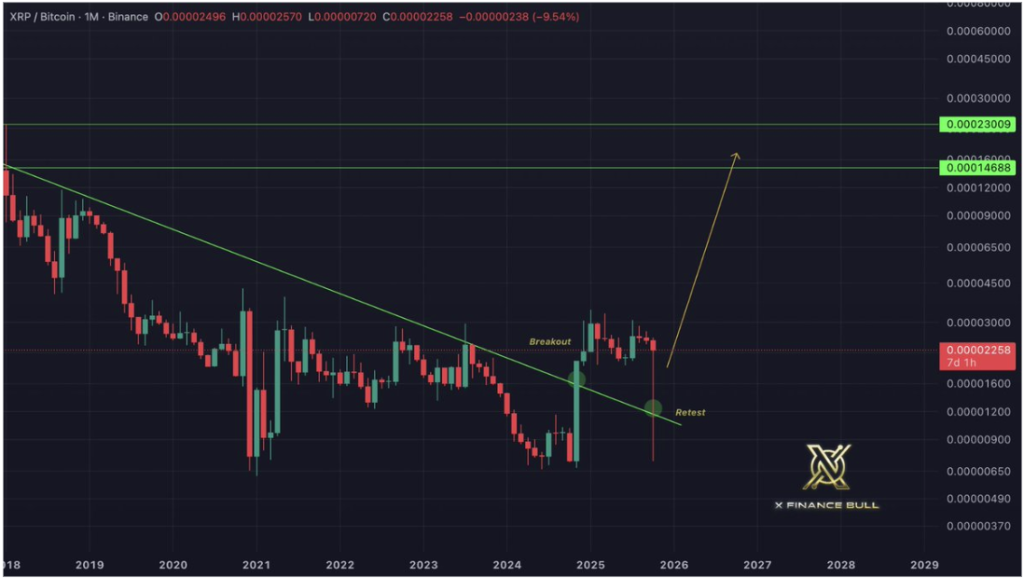
XRP/Bitcoin 1M chart. Source: @Xfinancebull
Since that retest, XRP has recovered impressively, with the pair maintaining a monthly close above the diagonal that once acted as a ceiling. This technical confirmation signals the completion of the breakout from the 2018 to 2024 downtrend that had defined XRP’s multi-year underperformance against Bitcoin. The monthly structure is now displaying the early signs of an upward shift, with the pair trading around 0.00002258 BTC.
According to the analyst, XRP is about to undergo a rally that massively outperforms Bitcoin and melts the face of many Bitcoin maximalists. XFB’s chart outlines two target zones ahead for XRP: 0.00014688 BTC and 0.00023009 BTC. The first target corresponds to the consolidation area seen between 2018 and 2019, while the second represents a major resistance cluster from the earlier phase of XRP’s creation. If XRP/BTC rallies to those levels, it would amount to approximately a 6x and 10x gain relative to Bitcoin, respectively.
The analyst also connects the technical setup to Ripple’s growing institutional ecosystem. He pointed to Ripple Prime, GTreasury, Metaco, Standard Custody, and Rail as part of the infrastructure that’s setting up XRP as a bridge asset for global finance. These partnerships give XRP an edge heading into the coming months, as it moves into real institutional utility and starts outperforming Bitcoin.
If these developments continue, the incoming decoupling of the XRP/BTC pair could become one of the most significant events for XRP. At the time of writing, XRP is trading at $3.63, up by 3.5% in the past 24 hours.
Featured image from Unsplash, chart from TradingView

Ethereum’s largest non-exchange holders are tiptoeing back into accumulation. On-chain analytics platform Santiment reported that wallets holding between 100 and 10,000 ETH, also known as whales and sharks, have begun to rebuild positions after unloading roughly 1.36 million ETH between October 5 and 16.
Notably, the Ethereum collective holdings chart shows that nearly one-sixth of those coins have already been clawed back, as some confidence starts to return to the second-largest crypto asset.
The first half of October was highlighted by one of Ethereum’s most pronounced periods of capitulation this year. Macroeconomic fears due to US tariffs saw the Bitcoin price undergo a flash crash that dragged many altcoins to the downside. During this move, Ethereum’s price also fell very quickly, dropping from highs around $4,740 on October 7 to as low as $3,680 on October 11.
Interestingly, on-chain data shows that the selling pressure from large holders amplified this move, as the chart from Santiment shows a steep decline in their cumulative holdings from about 24.5 million ETH to roughly 22.6 million ETH. This 1.9 million ETH drop reflected clear risk-off behavior among whales and sharks, who had been net buyers since August.
However, once selling momentum began to fade, accumulation started to return. Institutional inflows started to return into Spot Ethereum ETFs, and whale/shark trades started accumulating Ethereum. Since October 16, the same cohort that contributed to the liquidation has begun adding back to their positions. Santiment noted that these holders are finally showing some signs of confidence, demonstrating an incoming extended recovery phase following the shakeout.
According to Santiment’s data, the collective holdings of addresses with 100 to 10,000 ETH have rebounded to approximately 23.05 million ETH after bottoming out in mid-October. A highlighted annotation on the chart shows that 218,470 ETH were accumulated in just the past week, signaling a tangible shift in on-chain behavior.
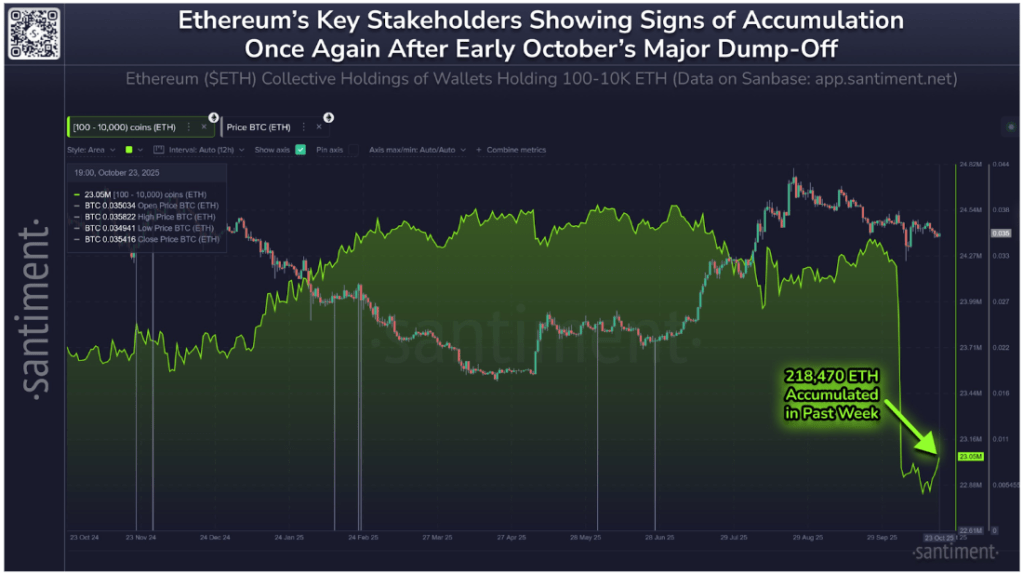
Ethereum collective holdings of wallets holding 100-10,000 ETH. Source: Santiment
This increase represents roughly one-sixth of the coins previously dumped, a sign that major investors are gradually re-entering the market after what appeared to be an exhaustion phase. Similar accumulation trends have often preceded a broader recovery in Ethereum’s price, especially when accompanied by stabilization in the ETH/BTC trading pair.
As it stands, the Ethereum price appears to be building a firmer base for the next phase of its recovery heading into November. When whale wallets accumulate, it reduces the circulating supply available on exchanges and reduces selling pressure.
At the time of writing, Ethereum is trading at $3,940 and is on track to break and close above $4,000 again. Both Ethereum and Bitcoin have risen a bit in recent days after inflation report showed US inflation cooling to 3% in September, below the 3.1% forecasted by economists.
Featured image from Unsplash, chart from TradingView

Dogecoin’s higher-time-frame structure is starting to look constructive again. In a technical analysis posted on X, crypto analyst EtherNasyonaL noted that Dogecoin’s market cap has completed a build, and momentum is ready, pointing to a cup-and-handle breakout retest breakout on the monthly market-cap chart.
The chart he shared shows Dogecoin’s market cap hovering just under $30 billion, riding above its 25-month moving average with a gentle series of higher lows that has been developing since the 2022 bear market base.
The chart shared by EtherNasyonaL looks at a cup-and-handle structure that has been developing on Dogecoin’s market cap chart for several years. The cup portion stretches across 2022 and 2023, a long and gradual recovery phase following Dogecoin’s blow-off peak in the 2021 bull market.
The handle is a narrowing consolidation under a descending resistance trendline that capped every attempt at recovery throughout the 2022/2023 bear market. Eventually, that resistance line was broken with a clean upward move in late 2024, confirming the first official breakout from the multi-year downtrend.
However, what makes this setup interesting is the successful retest of that same resistance line, now turned into support, where price action briefly dipped before bouncing again. This retest occurred mid-October, when the Dogecoin crashed to $0.15 very briefly.
The retest confirmed the breakout’s legitimacy, showing that Dogecoin traders defended the new support zone rather than allowing another breakdown. This kind of retest is known in technical analysis to lead to large directional moves, especially on higher timeframes where fewer false signals occur. EtherNasyonaL’s chart implies that Dogecoin has completed its build phase that lays the foundation for the next upward leg in its market cap.
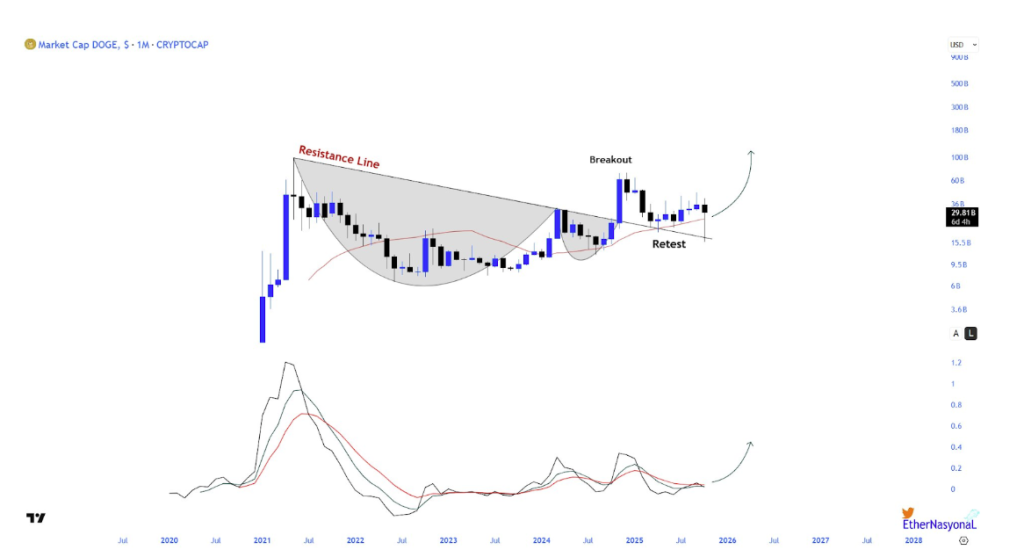
Dogecoin Market Cap. Source: @EtherNasyonaL on X
Another important element of EtherNasyonaL’s analysis lies in the consistent pattern of higher lows visible on the chart. Dogecoin’s market cap has formed a rising base since mid-2023, where each correction has ended above the previous one.
Equally important is the 25-month moving average (MA25) that runs beneath the candles. This indicator has acted as a dynamic support level for much of Dogecoin’s higher-time-frame structure. EtherNasyonaL noted this indicator’s role as the trend backbone by pointing out that this support has “continued to hold the price.”
As it stands, Dogecoin is now trading well above this moving average. As long as the market cap remains above it, Dogecoin’s structure will continue to maintain its bullish integrity. Should momentum continue to build as the MACD line turns upward, as the chart suggests, the conditions could align for Dogecoin’s next expansion phase. The next expansion phase could take Dogecoin’s market cap above $100 billion, as projected in the chart above.
At the time of writing, Dogecoin is trading at $0.20, with a market cap of $29.82 billion.
Featured image from Unsplash, chart from TradingView

As the crypto market evolves, Aptos (APT) continues to attract growing attention from investors looking for long term value in high performance blockchain projects. Aptos is built for speed; scalability and security; and is one of the most promising Layer-1 blockchains backed by Google Cloud, Microsoft and a16z.
As the year winds down; many investors are looking at Aptos price predictions for 2025 to 2027 to see how network upgrades; ecosystem growth and broader market trends will impact its value.
Aptos is a Move-based Layer-1 blockchain focused on scalability and security. It uses AptosBFT consensus and Block-STM execution engine for high throughput. Co-founders Mo Shaikh and Avery Ching (former Diem engineers) designed Aptos with novel tech (Parallel execution, Move smart contracts) to differentiate it from peers.
Experts call Aptos exceptional scalability; security and developer friendly; backed by institutional roots and funding. Its robust ecosystem is backed by major investors like a16z; Jump Crypto; FTX Ventures; and partners like Microsoft; Google Cloud, NBCUniversal; etc.
In 2024; Aptos saw explosive growth. Unique users quadrupled to 26 million and TVL hit about $668M. The network’s adoption with over 1 million daily active wallets in spurts; proves its use case for DeFi; NFTs, gaming and institutional use.
$APT is in the top 50 by market cap but 84% below its 2023 all-time high. Its tokenomics imply a slowly increasing supply. Ultimately, Aptos aims to compete with Ethereum/Solana by offering institutional grade”blockchain solutions.
| Metric | Value |
| Coin | Aptos (APT) |
| Launch Date | Mainnet Oct 2022 |
| Consensus | Proof-of-Stake |
| Market Cap | $2.32 billion |
| Circulating Supply | 718.15 million APT |
| Total Supply | 1.18 billion APT |
| All-Time High | $19.90 (Jan 2023) |
| All-Time Low | $2.22 (Oct 10, 2025) |
| % of Supply Staked | 71% of circulating APT |
| Key Partnerships | Microsoft; Google; NBCUniversal; BlackRock |
Aptos has had some big updates recently. In Aptos Experience 2025, the team showed off Shardines horizontal sharding, Raptr consensus engine and AI integration (Microsoft Aptos Assistant).
These are expected to bring higher throughput and usability. Infrastructure integrations have also advanced. Chainlink oracles went live on Aptos in H1 2025; enabling secure real-time data feeds for DeFi.
Wrapped BTC (xBTC) was launched on Aptos; bringing Bitcoin liquidity into its ecosystem. Stablecoin support grew; major stablecoins (USDC, USDT) launched on Aptos to use its low-fee network.
Aptos Labs led a funding round for gaming hub KGeN and acquired HashPalette, entering Japanese markets.
Media partnerships include NBCUniversal’s multi-year deal to build blockchain games on Aptos. Brevan Howard and BlackRock funds launched on the chain via Aptos Ascend, signaling growing institutional interest.
Metrics also improved. Report notes daily active addresses often exceed one million, peaking above 1.4 million in early 2025. TVL on Aptos reached $668M by mid-2025, four times its level early 2024.
Experts summarize Aptos’s position saying it has strong growth in network activity, adoption and ecosystem development, backed by partnerships and an ambitious roadmap. These developments support long term fundamentals which can drive price if adoption continues.
Several key factors impact Aptos’s price. Active users, transaction volume and TVL drive demand for $APT. Growing DeFi/NFT usage on Aptos means higher price. Sources show Aptos has above 600k daily active wallets, a solid base usage.
Crypto markets are sensitive to macro conditions like interest rates, US Dollar and regulations like SEC actions, ETF approvals. If regulators crack down on altcoins or DeFi, Aptos could suffer.
Broad crypto market trend like Bitcoin price, altcoin cycles and social/media hype affects $APT’s short-to-mid-term price. Sentiment indicators like Fear & Greed index and news flow are also notable factors. Negative headlines or market fear can trigger overreactions, as with any crypto
As of 2025, $APT is still below its 2023 high of $19.90. Technical analysis shows $APT could trade in a channel of $2.30-$3.30 in 2025. Some analysts predict November 2025 to be between $2.61-$4.54. This assumes year-end bullishness. Assuming 5% monthly growth; other experts predict $APT will be around $2.77 in Nov 2025, and slightly higher in Dec.
Looking closely at $APT; it could be around $3 by end-2025 in a base scenario. Upside catalysts like RWA inflows, new dApps, could push it to $4-$5 but if selling pressure from unlocks or bearish crypto markets dominate; it could fall to the $2-$3 range.
Below shows these predicted ranges:
| Month | Low Price (USD) | Average Price (USD) | High Price (USD) |
| Nov 2025 | $2.61 | $2.72 | $2.82 |
| Dec 2025 | $3.31 | $3.93 | $4.54 |
Note the relative volatility: December’s range is higher due to potential year-end factors; possibly crypto-cycle sentiment in 2026 prep.
Looking into 2026, forecasts are for gradual growth under neutral-to-positive conditions. $APT could average around $3.8-$4.0 in Q1 and $8.6 by year-end (with huge monthly swings). These projections assume improving sentiment. Some aggregated forecasts show an average around $6.71 for 2026 based on strong growth.
In a bull scenario, $APT could hit $10+ by late 2026 driven by breakthroughs like a big dApp launch. In a bear case, it may stay around $3-$4 all year. It should be noted that real prices will reflect actual adoption and market cycles.
Summarizing by quarter:
| Quarter | Estimated Price Range (USD) | Explanation |
| Q1 2026 | $2.60 – $4.66 | Starting flat, modest rise as ecosystem development continues. |
| Q2 2026 | $2.58 – $5.97 | Upgrades (Raptr/Move2) may boost activity; Volatility moderate. |
| Q3 2026 | $2.56 – $7.28 | DeFi and NFT launches could lift demand. |
| Q4 2026 | $2.53 – $8.59 | Year-end bullishness might push price higher if sentiment holds. |
For 2027; continued development could see more gains. $APT could average $10.36 by Q2 and $12.49 by year-end. Analysts say by 2027; Aptos could either compete with Solana-level L1s if adoption surges or settle as a niche chain.
The range below reflects this uncertainty. Under strong demand and bullish market, $APT could double or more from mid-2025 levels, whereas in a subdued scenario, it could just creep up to low single digits.
Breaking it down by quarter:
| Quarter | Estimated Price Range (USD) | Explanation |
| Q1 2027 | $3.35 – $9.65 | Continued growth if network maintains momentum. |
| Q2 2027 | $5.00 – $10.72 | Apex of many forecasts; high-end assumes full tech rollout. |
| Q3 2027 | $7.47 – $11.78 | Sustained ecosystem expansion (e.g. new staking, RWA projects). |
| Q4 2027 | $10.76 – $14.63 | Peak of bull scenario; base case would be lower if growth stalls. |
Different analysts and platforms have different $APT forecasts. Changelly’s analysts are super bullish, projecting multi-dollar $APT in 2025-27.
CoinCodex is bearish with 2025 averaging $2.58 and similar 2026 levels. SwapSpace aggregates show moderate growth to $7 in 2027. Binance community users’ consensus model suggests only small gains to $3.7 by 2027.
PricePrediction.net expects higher peaks of $6 by 2025 and $8.8 by 2026, whereas WalletInvestor is bearish with a low of $3 to $2 by late 2027.
These expert views show a big spread. Some think $APT will hit double digits, others expect it to stay at current levels.
The table below shows selected experts predictions for 2025-2027:
| Source | 2025 (Year-End) | 2026 | 2027 |
| Changelly | $15.61-$19.50 | $22.71-$27.11 | $32.12-$39.01 |
| CoinCodex | $2.28-$3.25 | $2.28-$3.25 | — |
| SwapSpace | Avg $5.05 | Avg $6.71 | Avg ~$7.18 |
| Binance (users) | $3.36 | $3.52 | $3.70 |
| WalletInvestor | $3.03 | $3.12 | $2.42 |
| PricePrediction | $5.97 | $8.84 | $12-$13 |
Looking at the remaining months in 2025; Aptos price prediction under different forecasts scenario could see $APT trading in the mid-single-digits by year-end.
Long-term speculations for 2026–2027 are extremely diverse. In a crypto bull-scenario and via the existing ecosystem expansion, $APT could run up to high single-digits and low double-digits.
However; in a neutral scenario, it may just creep up from current levels. Notable price drivers will be network adoption, big partnerships and overall market sentiment. Investors should note that no forecast is guaranteed; do your own research.
Layer 1 Blockchain: Base blockchain network that processes and finalizes transactions on its own protocol.
Move Language: Programming language originally developed for Diem (Meta’s project) now used by Aptos for smart contracts, designed for safety and flexibility.
Decentralized Finance (DeFi): Financial applications (like DEXs; lending) that run on blockchains without intermediaries.
Throughput (TPS): Transactions per second.
TVL: Total value of crypto staked or deposited in the protocol.
Aptos is a Layer-1 blockchain launched in 2022; by former Meta developers. It uses the Move programming language and is aiming for high transaction throughput and security. The native $APT token powers staking and governance.
Aptos’s price is affected by supply-demand, network adoption (users, TVL), market sentiment and regulatory news. Positive factors are successful partnerships, new dApps and bullish crypto cycles. Negative factors are market crashes; regulatory crackdowns or token unlock pressure. Macroeconomic trends also play a role.
Aptos Labs and the Aptos Foundation are leading development with backing from investors like a16z; FTX Ventures, Jump Crypto and partners like Google Cloud; Microsoft, SK Telecom and others. Recent collaborations are with NBCUniversal and finance firms like Brevan Howard; showing diverse support.
Assuming steady growth; many analysts are forecasting $APT to go up through 2027. Some experts estimate $3.52 by 2026 and $3.70 by 2027; and other analyses predicts up to $8-$14 in that timeframe. The actual outcome will depend on adoption and market conditions.
Read More: Aptos Price Prediction 2025–2027: Why Analysts See $APT Hitting Double Digits Soon">Aptos Price Prediction 2025–2027: Why Analysts See $APT Hitting Double Digits Soon

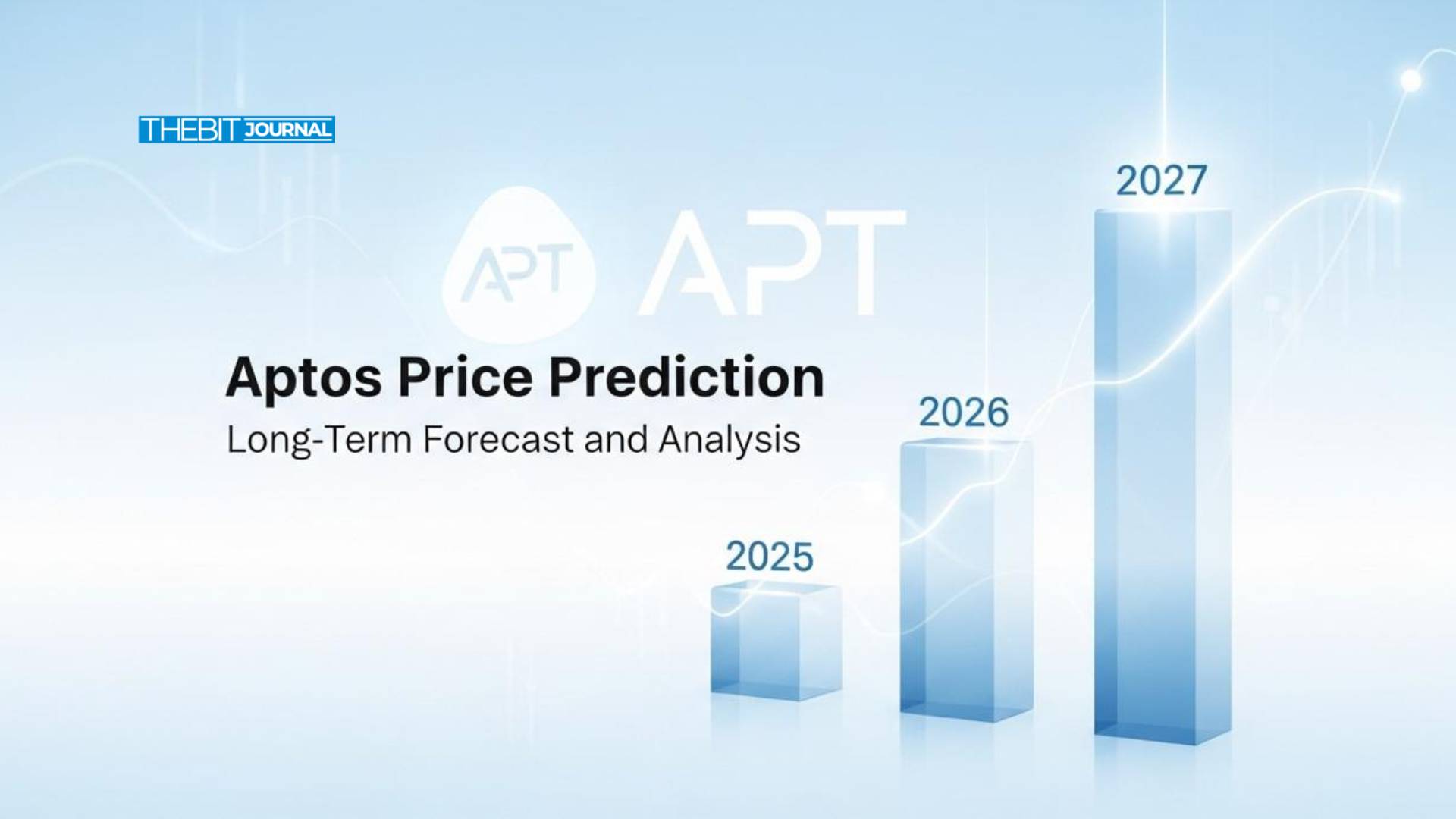
Updated on 26th October, 2025
Yield farming is not dead; it is different. When depth is thin or incentives stack, yields pop. When the market is heavy and funding cools, yields slip toward money-market territory. The profit story depends on where capital parks and how well risk is priced. Uniswap v4 cut costs for liquidity providers and pushed smarter fee design, which matters for net returns.
In the last cycle, farmers chased double-digit prints across exotic pools and got burned by drawdowns and hacks. This cycle looks more professional. Stablecoin rates cluster near front-end Treasuries, while structured yield protocols turn those rates into fixed and variable legs that can be traded. Galaxy’s research team described how on-chain “cash” tokens pass through the front-end curve, which is why base yields often sit near 4 to 5 percent when policy is tight.
Average lending yields on Ethereum hovered around the mid 4 percent range in mid 2025, with some networks a touch higher. That set the floor for many low risk strategies. From there, points, liquidity mining, and basis trades add the kicker.
There is still a spread between plain lending and structured yield. A snapshot from September showed blue chip lending near mid single digits, while yield tokenization platforms offered higher fixed coupons on specific assets. Uniswap v4’s lower gas and custom hooks made it cheaper to run active liquidity, so concentrated LPs can pick tighter ranges and capture more fees when volatility cooperates. The catch is inventory risk when price walks out of range.
Security remains the biggest tax on returns. Losses tied to hacks and scams in the first half of 2025 already surpassed the full year prior, with compromised wallets and access control issues leading the league tables. This is why protocol choice and operational hygiene are part of the yield equation. A single slip can erase a year of returns.
When Aave’s founder, Stani Kulechov, talks about the next wave, lenders listen. In October, he told followers that “embedded DeFi” is a “trillion dollar opportunity for fintechs,” pointing to broader distribution and cheaper on-ramps for yield. He also argued that falling policy rates can set the stage for a fresh DeFi upswing.
Arthur Hayes has been blunt about rate paths and the migration of money market cash into on-chain instruments. In a recent post he wrote, “sUSDe yields 7%, get ready for trillions in MMF looking for better yields,” tying policy moves to a rotation into tokenized cash strategies. That kind of flow lifts the baseline that farmers build on.
Real profit is not the headline APY. It is net of gas, slippage, impermanent loss for LPs, borrow rates for levered loops, and token price drift.
Uniswap v4’s fee architecture and gas savings help trim costs. Aave’s next modular upgrade aims to unify liquidity across markets, which can deepen books and lower the volatility of borrowing costs. Deeper markets let farmers size up without moving price too much, which keeps fills clean.
Points programs, partner incentives, and fee-sharing reforms can add a layer on top of base yields. A recent wave of proposals around revenue share and buybacks has reminded investors that protocol cash flows matter for token value, which feeds back into incentive budgets. When the market expects more durable fee flow, it becomes easier to justify measured farming risk rather than roulette.
Some dashboards will always highlight headline rates on small, volatile pools. Those prints look great on paper. They often vanish once size shows up. Traders with a plan use a simple test.
If an advertised rate requires thin liquidity, heavy emissions, or exposure to an asset with unstable mechanics, it is marketing, not income. If the strategy sits on credit markets with deep TVL and transparent risk, it is closer to a paycheck than a lottery ticket. That is the honest divide inside any hunt for highest APY yield farming.
One theme that did not exist at scale two years ago is the ability to lock a fixed rate against a floating leg on-chain. That turns a noisy stream of rewards into something a treasurer can plan around.
One large yield platform reported tens of billions in settled fixed yield and fresh TVL after new products went live, which shows real demand for certainty over hope. The choice between fixed and floating defines whether a farmer wants to clip a coupon or to speculate on the curve.
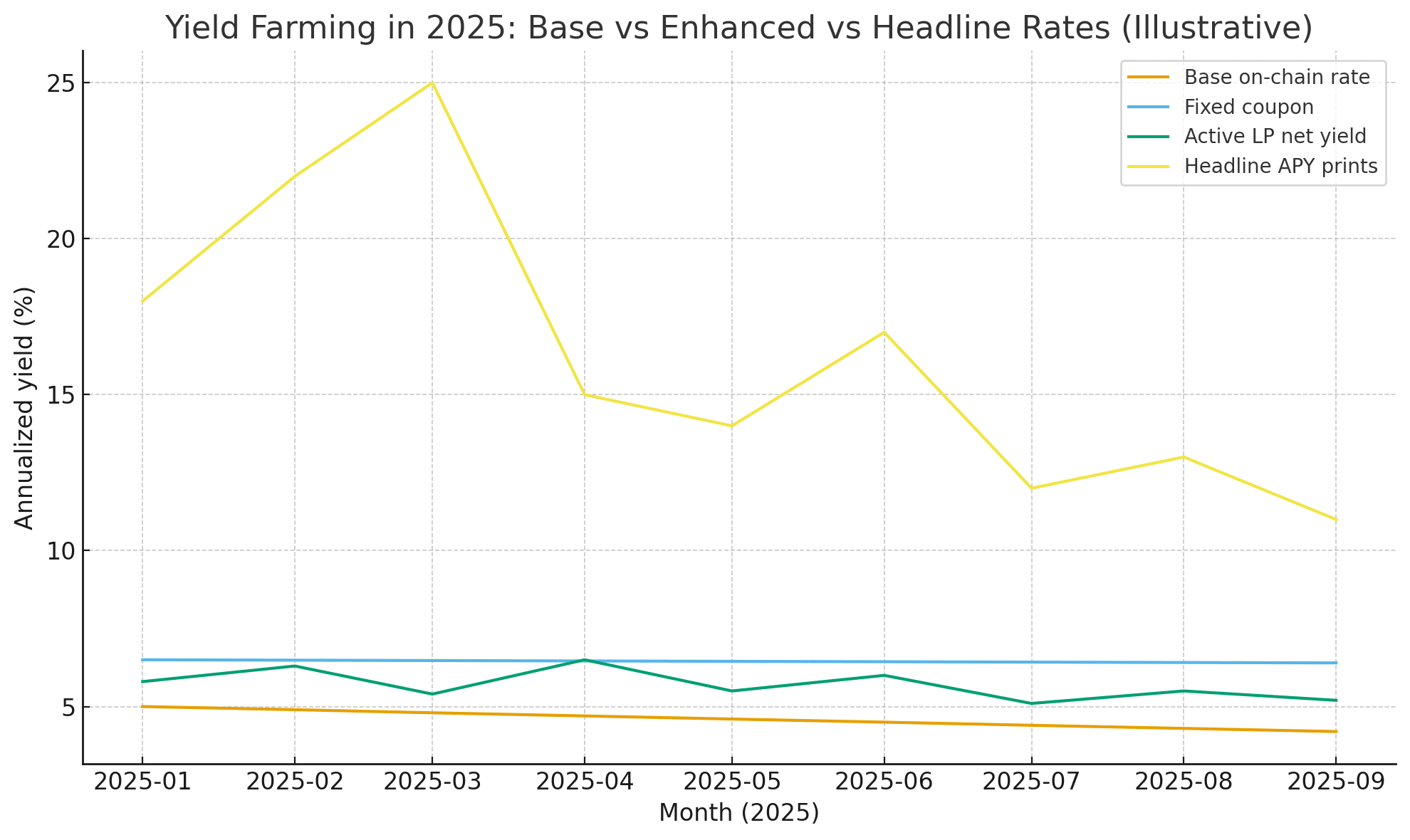
Even in blue chip venues, risk concentrates in a few buckets. Access control failures and private key compromises are a larger share of losses than pure code bugs. Cross-chain bridges and permission problems keep showing up in incident reports.
Anyone who treats yield as free lunch will learn the hard way that security posture and custody flow are part of the APR. These facts do not scare professionals away. They force better process.
Macro matters. If policy rates drift lower into 2026, base on-chain rates would soften, but risk spreads can widen and volumes can grow.
Builders expect more distribution through banking and fintech channels, which would push more deposits into on-chain credit. As Kulechov put it, “embedded DeFi” opens the door for mainstream platforms to route customers into transparent yield. That path supports durable, repeatable flows rather than short lived emissions.
Farmers who stayed in the majors and used fixed rate wrappers or hedged LP positions have seen steadier returns than the last cycle’s mercenary playbook. The trade looks more like cash management with optionality.
It is slower, but it tends to stick. Platforms that integrate tokenized cash, structured rates, and cleaner LP rails have drawn consistent TVL. Aave’s footprint and upcoming version shift are a good example of how depth turns into a de facto benchmark for on-chain credit.
The right headline is not about a single pool that shows a big number. It is about how the market prices time and risk. If the base is five percent and a structured leg offers several points more for a defined term with known counterparties and strong audits, that is a credible premium. If a farm needs thin books and an emissions firehose to get there, it is not a premium. It is a subsidy that will fade.
This is the part that demands discipline. The phrase highest APY yield farming will always trend. Editors can educate by explaining why concentrated LP ranges, fee tier choice, rebalance cadence, and liquidity around the mid decide if that headline rate survives contact with real volume. The industry learned the lesson in 2022. The survivors track depth and duration first, and only then chase extra points.
A major lending venue offering mid single digit rates on stablecoins sets the base case. A structured platform strips and sells fixed coupons at a higher rate for a three-month term. An LP on a top AMM uses a narrow tick range around an event to capture bursts of flow with lower gas costs than last year. None of these ideas are flashy. They scale. The common thread is risk that can be measured.
Yes, but it is selective. Profit lives where depth is real, security is boring, emissions are a bonus rather than the spine of the return, and strategy pays more than it costs to run. In plain terms, highest APY yield farming is not a destination. It is a filter to find sustainable cash flow in a market that finally prices risk like adults.
Yield farming is still profitable for those who treat it like a business and not a raffle. The winning playbooks lean on depth, security, and cost control, then add structured yield or targeted LP activity when the setup is right. The market is moving toward cleaner products, better distribution, and stronger rails.
That is good for real users and it is good for editors who want to report numbers that hold up over time. In that framing, highest APY yield farming becomes a test of which venues can pay without pretending, and which strategies scale when the music changes.
Is yield farming still profitable in 2025
It is profitable for disciplined strategies that prioritize deep, audited venues, stable base rates, and clear fee math. Stacks that include tokenized cash, fixed rate legs, or hedged LP positions tend to produce steadier results. The lure of highest APY yield farming is stronger than the reality unless the pool has real depth and known counterparty behavior.
What ruins returns the fastest
Security events, thin liquidity that amplifies price moves, and poor inventory management. Reports show that compromised access and bridge issues are frequent culprits, which is why custody and permissions need adult supervision.
Do falling interest rates help or hurt
Lower base rates can trim easy passive returns. They can also pull more users into DeFi if borrowing gets cheaper and products feel safer. Leaders in lending argue that a friendlier rate path sets the stage for a new upswing. Highest APY yield farming then becomes a story about volume and design, not handouts.
Are fixed yields a fad
No. The growth in settled fixed yield and TVL suggests durable demand from users who want certainty. It looks like an on-chain cousin of corporate cash management. Farmers can still take a view by going long or short the floating leg. Highest APY yield farming can include fixed coupons if the structure is fair and transparent.
Where should new capital look first
The majors. Deep lending markets, top AMMs, and structured yield platforms with audits and battle tested code. From there, layer on incentives or points. This is the healthier side of highest APY yield farming because base returns are solid before bonuses.
Concentrated Liquidity Provider Position
A position on an automated market maker that earns fees only within a chosen price range. It provides higher capital efficiency but carries inventory risk if price exits the range. Uniswap v4 lowered costs to manage these positions at scale.
Fixed and Floating Yield Leg
A structure where one side receives a fixed rate for a term while the other receives whatever the market pays. On-chain platforms tokenize both legs so users can trade or hold either stream of cash flows. Growth in settled fixed yield shows adoption.
Impermanent Loss
The difference between holding tokens and providing them as liquidity in a pool. If price moves, the pool may underperform a simple hold. Active ranges and fee tiers can offset the drag when volume is strong. Uniswap v4’s features help reduce overhead.
Order Book Depth Around the Mid
The amount of buy and sell liquidity close to the current price. Deep books absorb larger trades without big price moves. Depth is a hidden driver of net APY because slippage and missed fills eat return.
Tokenized Cash Strategy
A token that passes through money market yields from short term Treasuries and repo. These APYs track the front end of the curve with small basis differences. Many farmers treat them as a base layer.
Unified Liquidity Architecture
A design that aggregates borrowing and lending across markets to improve efficiency. Planned changes in top lending venues aim to reduce fragmentation and stabilize rates for farmers.
Read More: Is DeFi Yield Farming Worth It Anymore? A Data First Verdict for 2025">Is DeFi Yield Farming Worth It Anymore? A Data First Verdict for 2025


The financial world is witnessing an unprecedented shift, as Ethereum solidifies its position as the sole asset capable of becoming a multi-trillion-dollar institutional store of value. ETH is the only one currently demonstrating the scale, utility, and institutional acceptance to command and securely hold multi-trillion-dollar allocations, fundamentally redefining the future of global wealth preservation and growth.
Ethereum has quietly become the final form of digital trust for institutions to store trillions of dollars. A market expert and entrepreneur, partnering with OKX and MEXC, Ted Pillows, has stated on the social media platform X that ETH decentralization is nearly impossible to replicate, a network that was largely community-funded, not VC-funded, and forged through proof-of-work (PoW).
Furthermore, the reliability of ETH has been 100% uptime over 10 years of flawless operation and 16 successful upgrades. The ETH Layer 1 and Layer 2 architectures are designed to offer regulatory safety, where institutions can deploy compliant solutions. Meanwhile, the KYC-enabled Layer 2s do not compromise on the fundamental decentralization or security of the leading ETH blockchain.
While Ethereum is a safe place for institutional investors to store trillions of dollars, analyst Luca has noted that the ETH price has shown strength as it bounced off the Weekly Bull Market Support Band, which has previously acted as a strong reversal over several weeks. This level also aligns with the high-timeframe support area marked in green, the same zone that served as a major resistance throughout most of 2024.
Luca believes that due to this confluence, and as long as the price holds above this range, the broader market structure will continue to favor the upside. However, ETH still faces a critical test ahead. Until it breaks above the golden pocket between the 0.5 and 0.618 Fibonacci retracement Point of Interest (POIs), the same zone that triggered the last rejection, the analyst highlighted that the best approach is to stay somewhat cautious. He also added that investors should be ready for further consolidation within the high-timeframe accumulation range.

As Luca has highlighted, the priority now is risk management. Avoid unnecessary leverage, don’t overexpose on short-term setups, and maintain a diversified portfolio with moderate exposure to defensive sectors. This will help ride out the volatility as ETH moves closer to the top of the cycle. While advocating for a cash buffer, the expert noted that if ETH breaks below the Weekly Bull Market Support Band, it would signal a potential deeper downside and justify hedging part of spot holdings to mitigate short-term risk.

The internet is changing fast. What started as simple web pages has now become a world full of digital ownership, smart contracts, and crypto payments. This is the third generation of the internet, which is referred to as Web3. But there is one big problem. It is not easy to use.
There is a large number of individuals who wish to use blockchain applications, to them halted due to their lack of knowledge regarding how wallets, gas charges, and private keys function. It is even frightening to connect a wallet or authorize a purchase. That is why user experience, or UX, is so significant in Web3.
To put it in simple terms, UX refers to the ease or the difficulty of using a product. Poor UX causes users to abandon them, and good UX causes users to come back. Web3 UX is in the infancy stage, and everything is a bit complex. It must be simplified to access more users, like regular applications like Google Pay or Instagram.
In order to become something that people can bring into daily life, blockchain should become invisible. The user is not supposed to be aware that he or she is using it. The system should work smoothly in the background, and that is where the future of Web3 UX is heading.
Even though Web3 is full of new ideas, it has one major weakness. It is still made for tech people, not for everyone. Many users find it too complex to even start.
There are three big reasons that make Web3 hard for most people today.
A crypto wallet is needed for almost every Web3 app. But for new users, setting it up can be confusing. There are seed phrases, passwords, private keys, and backup rules. One small mistake can make someone lose all their funds forever. In regular apps, people can reset their passwords easily. But in blockchain, once it’s gone, it’s gone.
This fear makes many people stop before even starting. A better UX will have to remove this fear by offering safe, easy recovery and clear steps.
Every blockchain transaction needs gas fees. These are small payments made to confirm the transaction. But users don’t always understand what gas is or why the price keeps changing. On busy days, the fees can go up suddenly, and that makes people angry or confused.
Future Web3 UX will need to make this automatic. The system should pick the right gas fee and show a simple message like “Your transaction will complete in 10 seconds.” That is how easy it should feel.
Most Web3 sites are still built for developers. They often use tech words like “bridge,” “staking,” or “hash” that make no sense to regular users. Simple design, clear buttons, and easy words are what the next phase of Web3 UX needs.
Blockchain will not go mainstream unless it becomes easy enough for anyone to use. Most people don’t want to think about how something works inside. They just want to use it and get results.
Simplifying Web3 UX means hiding the complicated parts and showing only what’s needed. When people can open an app, buy something, and sign a transaction without fear or confusion, that is when blockchain will really grow.
Better UX also means trust. When users feel safe and confident, they spend more time in the ecosystem. They explore NFTs, DeFi, and games. They bring friends too. That is how mass adoption starts. Here is an example of what before and after UX improvement can look like:
| Action | Before UX | After Simplified UX |
| Send crypto | Enter address manually | Choose contact name |
| Pay gas fees | Set manually | Auto-calculated in app |
| Sign transactions | Use long wallet popups | One-tap confirmation |
| View balance | Check explorer | Visible inside the app |
| Manage keys | Manual backups | Cloud + social recovery |
This table shows how simplification can make blockchain act more like normal apps. Small improvements like these can change everything for new users.
Once blockchain tools become simpler, more people will join. It is the same story as the early internet. At first, only developers used it. Then came browsers and search engines. The same will happen with Web3. When the UX becomes smooth, adoption will follow.
Some projects already understand how big UX is for the future. They are trying to fix problems and make blockchain easier to use for everyone.
MetaMask used to feel complex for many new users, but over time, it improved. It added features like one-click token swaps, easy network switching, and now even mobile login. The app also shows warnings for risky websites, which helps protect beginners.
Coinbase is known for making crypto easier for normal users. It hides complex actions behind simple buttons like “Buy,” “Send,” or “Receive.” The app also connects directly to Web3 dApps through its wallet extension, which removes many confusing steps.
Another big improvement comes from networks like Arbitrum and Polygon. They help cut gas fees and make transactions faster. For users, this means cheaper actions and fewer failed transactions. That alone improves the overall experience.
Here’s a small table comparing some popular Web3 wallets and their UX features.
| Wallet Name | Speed | Design Simplicity | Recovery Option | Cross-Chain Support |
| MetaMask | Medium | Good | Seed phrase only | Yes |
| Coinbase Wallet | Fast | Very Easy | Cloud backup | Yes |
| Trust Wallet | Fast | Simple | Recovery phrase | Yes |
| Rainbow Wallet | Medium | Modern UI | Social login | Partial |
| Phantom (Solana) | Very Fast | Excellent | Recovery via seed | No |
This comparison shows that wallets are slowly moving toward simplicity. Future ones will likely combine the best of all: one-click recovery, low fees, and clean designs.
Artificial intelligence is starting to play a big role in Web3 design. It helps remove small confusions and guide users better. AI can make blockchain easier in many ways, like automating gas fee selection, predicting user intent, and helping with lost keys.
Some wallets now use chatbots that talk with the user. Instead of clicking through complex menus, users can just type what they want. For example, “Send 10 USDC to Alex,” and the AI assistant prepares the transaction.
AI can also predict network congestion and suggest the best time to make a transaction. It can calculate the best fee for the fastest confirmation. This not only saves money but also makes blockchain use feel smooth and intelligent.
| AI Feature | Benefit to Users | Example in Web3 |
| Auto gas calculation | No manual setup | MetaMask AI plugin |
| Transaction prediction | Faster approvals | Arbitrum AI integration |
| Voice or chat commands | Easier to interact | AI wallet assistants |
| Fraud detection | Safer experience | Coinbase security AI |
AI takes away guesswork. It turns a complex blockchain task into something anyone can do without fear. This mix of AI and UX is the next big step for Web3 apps.
One of the biggest issues in Web3 is how many blockchains exist. Ethereum, Solana, BNB Chain, Avalanche, and so many more. Each one works differently and uses its own tokens. For normal people, this can be confusing. They don’t understand why they can’t move coins easily from one to another.
Cross-chain UX is trying to fix this. It means building apps that work across different blockchains in a single interface. When users can do everything from one place, blockchain starts to feel like one connected internet, not a group of small islands.
A big trend now is multi-chain wallets. These wallets let users send or receive tokens on many blockchains without leaving the app. For example, Trust Wallet and OKX Wallet support dozens of networks on one screen. Users can switch between chains like Ethereum or BSC without even knowing what’s happening under the hood.
This kind of experience hides the complexity and makes blockchain feel like a normal digital app.
Cross-chain UX makes things smoother for developers and users both. It means people can buy an NFT on Polygon and then use it in a game built on Arbitrum. No need to worry about bridges or manual transfers. That’s what future apps will look like: simple, connected, and user-friendly.
| UX Feature | Old Way | New Cross-Chain UX |
| Token transfers | Bridge manually between chains | Done inside wallet |
| App access | One app per blockchain | One app for all chains |
| Fees | Pay in each network token | Unified gas token system |
| NFT use | Locked to one chain | Shared between multiple chains |
Cross-chain UX is what will make blockchain feel complete. It removes the feeling of walls between chains and helps new users see Web3 as one whole ecosystem.
UX design in blockchain is not just about color or buttons. It’s about making something hard feel natural. The way users interact with wallets, tokens, and dApps is changing fast. Some design trends are now leading the next wave of Web3 UX.
Some platforms now pay the gas fee for users or let them pay it in stablecoins. This removes a big confusion. Users don’t need to know about ETH or MATIC tokens to make transactions. It feels more like using an app that just works.
Instead of long wallet addresses, some projects now let users use simple names like “john.eth” or “sara.crypto.” These are called ENS (Ethereum Name Service) domains. It makes sending tokens easier and safer because no one has to copy long codes.
Losing a seed phrase used to mean losing everything. Now, wallets are adding social recovery. It means friends or trusted contacts can help restore access if someone forgets their password. This feels more like normal internet apps.
| Trend | What It Fixes | How It Helps Users |
| Gasless payments | Removes gas confusion | Makes sending faster |
| Simple wallet names | Long codes are hard | Easier to share |
| Social recovery | Seed phrase loss | Safer access |
| Mobile-first design | Desktop-only use | Brings blockchain to phones |
These design trends show that Web3 is learning from Web2. The goal is to make blockchain tools work for everyone, not just developers.
Although UX is improving, developers continue to struggle a lot in their attempt to make Web3 easy. Blockchain is not just a normal database, and that complicates things.
One of them is the challenge of simplicity and decentralization. Developers would like to simplify things, but they also wish to have the users in control. One such example is to make apps centralized by adding password recovery. Then they have to strike a compromise.
Slow onboarding is another issue. Upon registration, new users must create wallets, keys, network connectivity, and even purchase crypto first. That’s a lot for a beginner. Making this process easier without violating the blockchain regulations is time and testing.
Some apps become slow when the network is busy. That also hurts UX. Developers must design systems that stay fast even with millions of users.
| Developer Problem | Why It’s Hard | Example |
| Balancing control | Easy UX vs user ownership | Custodial vs non-custodial wallets |
| Complex onboarding | Too many steps for new users | Wallet setup confusion |
| Network limits | High gas and lag | Ethereum congestion |
| Security trade-offs | Simpler UX can mean risk | Auto-sign features |
These problems show why Web3 UX is not easy to fix overnight. But step by step, it’s getting better with new ideas and community testing.
The future of Web3 depends on how easy it becomes to use. If people can use blockchain without stress or fear, it will spread faster than ever. Simplicity is not just about good design; it’s about trust. When apps are clear, users trust them more.
Blockchain started as a tech project, but it will become part of normal internet life through better UX. AI, automation, and multi-chain support are already showing that direction. One day, people won’t even say they are using blockchain; they will just use it. That’s when Web3 truly becomes mainstream.
The abbreviation of user experience is UX. In Web3, it refers to the ease or the complexity of using a blockchain application. With a decent UX, users should be able to buy, send, or trade crypto without worrying or having to understand technical aspects.
Web3 applications are more difficult as they require distinguishing such aspects as keys, wallets, and gases payments that are not regularly encountered by ordinary users. All these are concealed behind some casually placed buttons in normal apps, but Web3 still displays too much technical data in the first place.
Once Web3 apps are easy and approachable, they will be used more by people. The UX should be smooth as this creates a feeling of trust and confidence so that users can navigate crypto without fear. It transforms blockchain into one of the baffling technologies into something that anybody can use in everyday life.
Coinbase Wallet, Trust Wallet, and Rainbow Wallet are some of the already-improving wallets. They are designed with intuitive designs, quick logins, and simple recoveries. Such minor additions allow amateurs to get into Web3 without being confused and intimidated.
Yes, AI can make blockchain apps much simpler. It can explain what transactions mean, help pick gas fees, warn about risky websites, and even recover lost accounts. With AI guidance, Web3 apps will feel smarter and more user-friendly for everyone.
The next generation of the internet that runs on blockchain technology. It allows users to own their data, use crypto, and interact directly with decentralized apps instead of big companies controlling everything.
How a person feels when using a product or app. In Web3, it means how easy or hard it is to use wallets, trade crypto, or understand smart contracts.
A digital system that records information in a secure and transparent way. It stores data across many computers so no one person or company can control it.
A digital tool used to store and send cryptocurrencies. It can be a mobile app, browser extension, or hardware device that helps people manage their blockchain assets.
A small payment made to blockchain validators who confirm and record transactions. It is like a service charge for using the blockchain network.
The future of Web3 depends on how simple it becomes to use. Right now, many people stay away from blockchain because it feels too technical. Complicated wallet setups, seed phrases, and gas fees confuse users who just want easy tools.
But the new wave of UX improvements is changing this. Developers and designers are focusing on clean interfaces, automatic gas settings, human-readable wallet names, and better onboarding experiences. AI is also stepping in to help people understand what they are doing without getting lost in blockchain terms.
Cross-chain tools are making it possible to move tokens between networks easily, so users no longer feel stuck in one place. This new direction is what will make blockchain as normal as using social media or online banking.
A future Web3 app might let someone buy, trade, or store digital assets without even realizing they are using blockchain. That’s the goal, to make Web3 so smooth and natural that it just works. When that happens, blockchain will finally reach the mainstream world and become a part of daily life.
Read More: The Future of Web3 UX: How Simplifying Blockchain Can Bring Mass Adoption">The Future of Web3 UX: How Simplifying Blockchain Can Bring Mass Adoption


Coinbase has been on a buying spree.
On Oct. 21, the publicly traded crypto exchange announced that it is acquiring early-stage investing platform Echo for $375 million in cash and equity.
Notably, the acquisition marked the eighth buy for the San Francisco-based company in 2025 so far, according to The Wall Street Journal. Of those eight deals, three involved undisclosed businesses.
Overall, since its 2012 inception, Coinbase has acquired dozens of companies, per Crunchbase data. Besides Echo, it announced purchases of the following startups in 2025:
Coinbase’s buying sprees seem to come in spurts, according to the data.
For example, in 2018, it acquired eight known companies. And then in 2021, it picked up seven known companies. But most years, it acquired only one or two companies.
Interestingly, 2018 was defined by what has been described as the “Great Crypto Crash,” or a massive market sell-off after the boom that took place in 2017. Things had rebounded by 2021, which saw a bull market for crypto and the rise of NFTs and DeFi. That November, Bitcoin hit an all-time high of $68,000.
After a bumpy few years, which saw the arrests of FTX founder Sam Bankman-Fried and Binance CEO and founder Changpeng Zhao, Bitcoin has rebounded, surging to an all-time high in 2025. Prices reached $113,156.57 on Oct. 15.
In announcing its plan to acquire Echo, Coinbase said the two companies shared a similar mission of “democratizing early-stage investing, so that more people can support the next generation of breakthrough companies.”
The buy complemented its earlier acquisition of Liquifi, Coinbase said, noting that: “While Liquifi strengthened our ability to support builders at the start of their journey, Echo extends that support into fundraising.”
The largest of its acquisitions in 2025 so far, though, was its $2.9 billion buy of Deribit.
Meanwhile, Coinbase’s market cap as of Oct. 23 hovered just under $83 billion, while its stock is up over 25% year to date.
Illustration: Dom Guzman
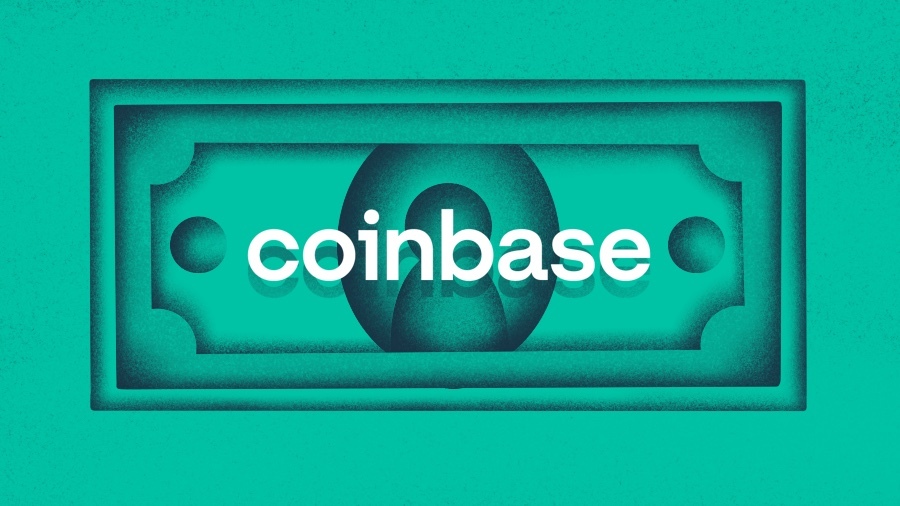
Blockchain enhances trust in AI systems, according to FICO's Dr. Scott Zoldi, highlighting the synergy between AI and blockchain technologies.
The post Auditable AI: Building trust in AI through blockchain appeared first on CoinGeek.
